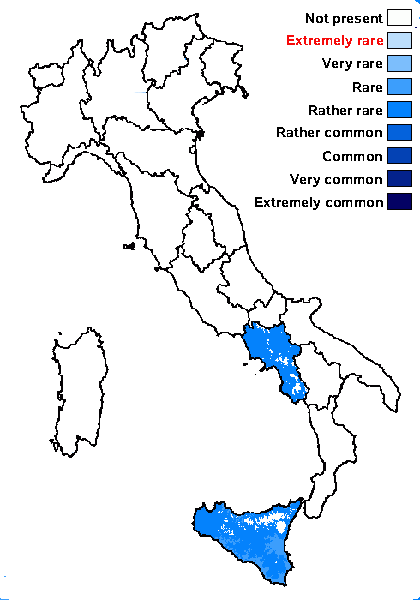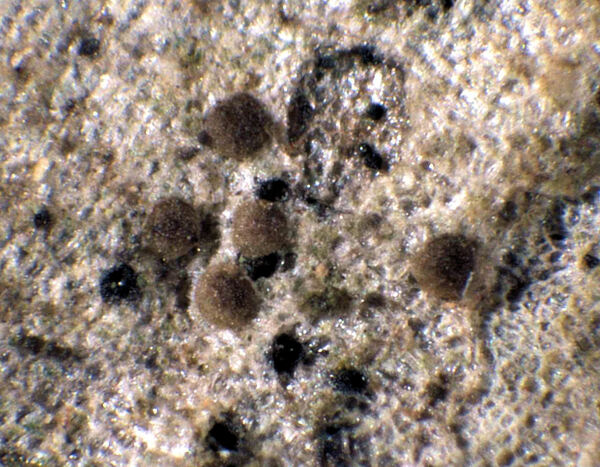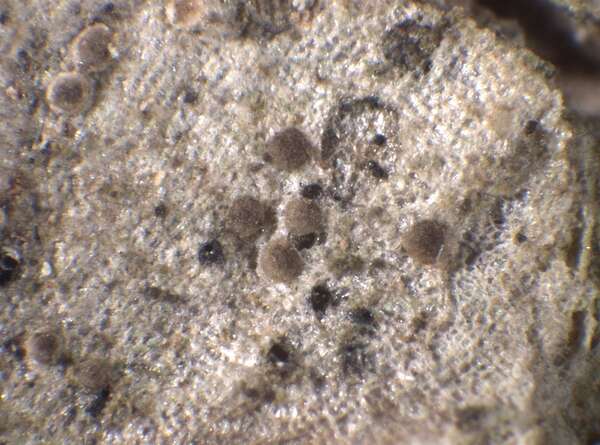Lecania sambucina (Körb.) Arnold
Flora, 67: 416, 1884. Basionym: Biatorina sambucina Körb. - Parerga Lichenol., 2: 137, 1860.
Synonyms: Diphratora sambucina (Körb.) Jatta; Lecania cyrtella subsp. sambucina (Körb.) Arnold; Lecaniella sambucina (Körb.) Jatta
Distribution: S - Camp (Jatta 1909-1911), Si (Jatta 1909-1911).
Description: Thallus crustose, very thin, continuous to somehow granular and uneven, pale to dirty grey-green or white. Apothecia lecanorine at least when young, round, adpressed, emergent to sessile, 0.2-0.4 mm across, with an orange-brown to dark brown, flat to finally convex disc (translucent and dark-spotted when wet), and a rather thin, smooth to crenulate, often finally excluded, white or pale grey thalline margin. Proper margin thin, dark brown; epithecium pale brown, often with fine pigment granules, K+ reddish; hymenium colourless to brownish, 45-65 µm high; paraphyses coherent, simple, 1.5-2 µm thick at base, the apical cells pale to dark brown, 2-3(-4) µm wide; hypothecium colourless. Asci 10-16-spored, clavate or inflated-clavate, with a K/I+ blue apical dome penetrated by a narrow, K/I- apical cushion surrounded by a narrow, deeply K/I+ blue zone, the wall K/I- but surrounded by an I+ red-brown, K/I+ blue outer layer, the ocular chamber relatively small, Biatora-type. Ascospores 1-septate hyaline, narrowly ellipsoid, oblong to almost fusiform, (9-)10-14(-16) x 3-4(-4.5) µm, without a gelatinous perispore. Pycnidia rare, immersed, the wall pale brown in upper part, colourless below. Microconidia thread-like, curved. Photobiont chlorococcoid. Spot tests: thallus K-, C-, KC-, P-, UV-. Chemistry: without lichen substances. Note: this species appears to prefer lichen-rich communities on old deciduous trees with rough, base-rich bark, such as Sambucus, Populus and Salix. It is probably widespread throughout Europe, but very likely overlooked or mistaken for L. cyrtella, with which it has been often synonymised. For further details see Reese Næsborg (2008).
Growth form: Crustose
Substrata: bark
Photobiont: green algae other than Trentepohlia
Reproductive strategy: mainly sexual
Commonnes-rarity: (info)
Alpine belt: absent
Subalpine belt: absent
Oromediterranean belt: absent
Montane belt: absent
Submediterranean belt: rather rare
Padanian area: absent
Humid submediterranean belt: rather rare
Humid mediterranean belt: rather rare
Dry mediterranean belt: rare

Predictive model
Growth form: Crustose
Substrata: bark
Photobiont: green algae other than Trentepohlia
Reproductive strategy: mainly sexual
Commonnes-rarity: (info)
Alpine belt: absent
Subalpine belt: absent
Oromediterranean belt: absent
Montane belt: absent
Submediterranean belt: rather rare
Padanian area: absent
Humid submediterranean belt: rather rare
Humid mediterranean belt: rather rare
Dry mediterranean belt: rare

Predictive model
 INDEX FUNGORUM
INDEX FUNGORUM
 GBIF
GBIF




